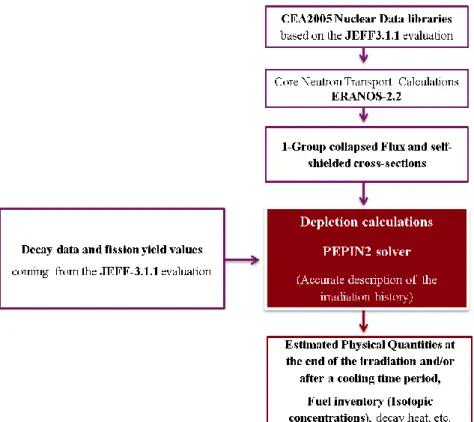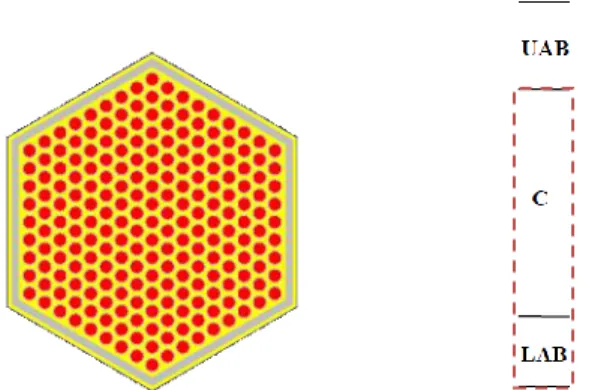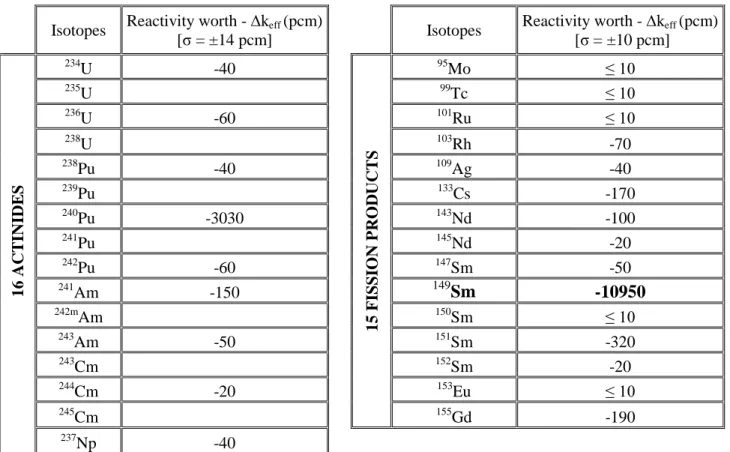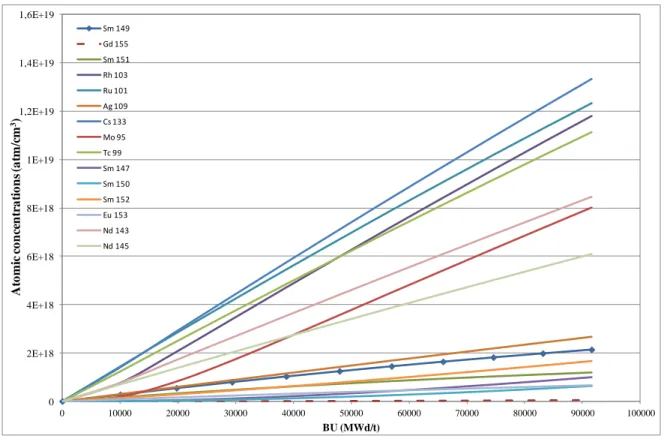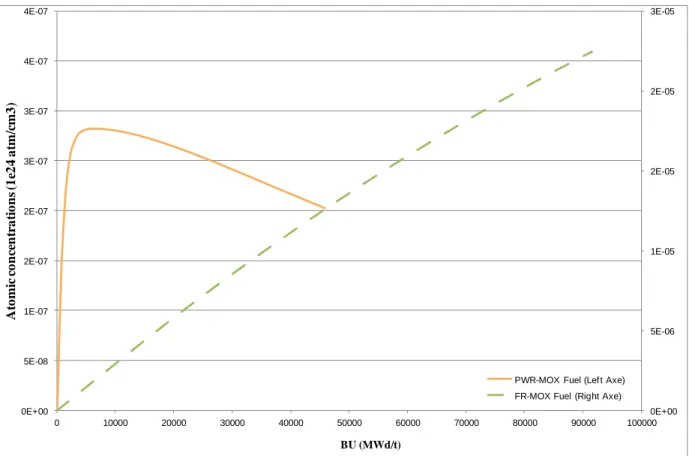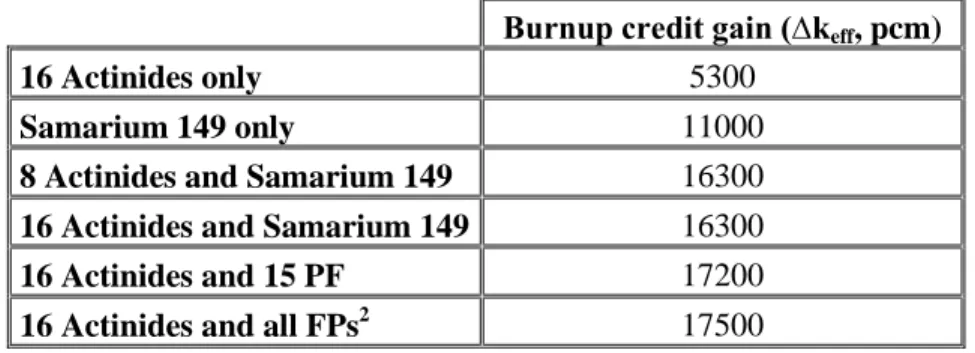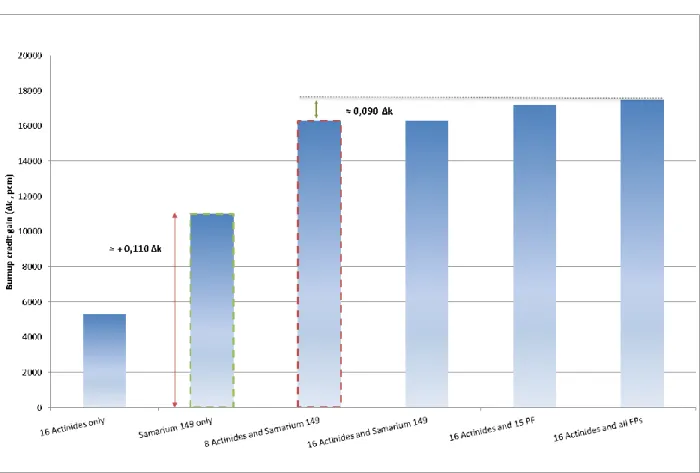HAL Id: cea-02492566
https://hal-cea.archives-ouvertes.fr/cea-02492566
Submitted on 27 Feb 2020HAL is a multi-disciplinary open access archive for the deposit and dissemination of sci-entific research documents, whether they are pub-lished or not. The documents may come from teaching and research institutions in France or abroad, or from public or private research centers.
L’archive ouverte pluridisciplinaire HAL, est destinée au dépôt et à la diffusion de documents scientifiques de niveau recherche, publiés ou non, émanant des établissements d’enseignement et de recherche français ou étrangers, des laboratoires publics ou privés.
A burnup credit approach for irradiated fast-neutron
reactor fuels nuclides of interest and fuel storage
application
C. Carmouze, C. Riffard, G. Grassi
To cite this version:
C. Carmouze, C. Riffard, G. Grassi. A burnup credit approach for irradiated fast-neutron reactor fuels nuclides of interest and fuel storage application. ICNC 2015 - 9th International Conference on Nuclear Criticality Safety, Sep 2015, Charlotte, United States. �cea-02492566�
A BURNUP CREDIT APPROACH FOR IRRADIATED FAST-NEUTRON
REACTOR FUELS: NUCLIDES OF INTEREST AND FUEL STORAGE
APPLICATION
Coralie CARMOUZE, Cécile RIFFARD
Commissariat à l'Énergie Atomique et aux énergies alternatives (CEA) DEN, DER, SPRC, F-13108 Saint Paul les Durance, France
coralie.carmouze@cea.fr ; cecile.riffard@cea.fr Gabriele GRASSI
AREVA-NC, Recycling Operations F-92084 Paris La Défense, France
gabriele.grassi@areva.com
ABSTRACT
The concept of taking into account the reduction of the reactivity of nuclear used fuel due to their burnup is referred to as “Burnup Credit” (BUC). Economic incentives offered by the implementation of a BUC methodology in criticality analyses of Light Water Reactor (LWR) used fuel facilities are nowadays well-demonstrated.
The current prospect of reprocessing the fissile and fertile subassemblies of the PHENIX reactor in France, and the development of the 4th-Generation Fast-neutron Reactors (FR) enable research projects in relevant fuel cycle operations. Under these circumstances, the CEA and AREVA-NC have decided to study a burnup credit approach for irradiated fuels of the PHENIX reactor.
This paper focuses on a preliminary investigation on the use of burnup credit for used FR fuel operations. The first step consists in analyzing and selecting the nuclides of interest for burnup calculation, on the basis of the 27 BUC nuclides (12 actinides and 15 fissions products) chosen for LWR-MOx fuels [1]. These nuclides are then involved in a criticality calculation (a used fuel pool) to highlight the interest of a BUC approach.
This study highlights the interest of a burnup credit approach for FR fuels and shows that the highest contribution to reactivity loss is due to only one fission product: the 149Sm. The opportunity to take account of only one fission product is highly promising and will considerably simplify the way to determine a penalizing fuel inventory. Moreover, it is to notice that results for different configurations may differ from those obtained for a fuel storage application. Thus, specific analyses have to be carried out in order to study the applicability of the conclusions of this paper.
KEYWORDS Burnup Credit, Fast-Neutron Reactors, Used fuel, Criticality
1. INTRODUCTION
The concept of taking into account the reduction of the reactivity of nuclear used fuel due to their burnup is referred to as “Burnup Credit” (BUC). Economic incentives offered by the implementation of a BUC methodology in criticality analyses of Light Water Reactor (LWR) used fuel facilities are nowadays well-demonstrated.
The current prospect of reprocessing the fissile and fertile subassemblies of the PHENIX reactor in France, and the development of the 4th-Generation Fast-neutron Reactors (FR) enable research projects in relevant fuel cycle operations. Under these circumstances, the CEA and AREVA-NC have decided to study a burnup credit approach for irradiated fuels of the PHENIX reactor.
This paper focuses on a preliminary investigation on the use of burnup credit for used FR fuel operations. The first step consists in analyzing and selecting the nuclides of interest for burnup calculation, on the basis of the 27 BUC nuclides (12 actinides and 15 fissions products) chosen for LWR-MOx fuels [1]. These nuclides are then involved in a criticality calculation (a used fuel storage pool) to highlight the interest of a BUC approach.
This study has been carried out using the latest version of the nuclear data library JEFF-3.1.1 [2], the latest version of the fuel cycle package DARWIN2.3 [3], recently validated for FR fuels [6], and the new version of the criticality-safety package CRISTALV2.0 [8].
It is to notice that the study does not use bounding values nor penalizing assumptions: depletion calculations use nominal conditions of irradiation, the fresh fuel inventory values corresponding to mean values as the average burnup used.
2. CALCULATION METHODS, ASSUMPTIONS AND MODELS 2.1. Calculation tools
The PEPIN depletion solver of DARWIN calculates the isotopic concentrations at the end of the irradiation or after a cooling time. Then, these concentrations are used as input data in the Criticality-Safety package CRISTAL providing the effective multiplication factor (keff) associated to the calculated configuration.
2.1.1. Depletion calculations with DARWIN2.3
DARWIN2.3 [3] is the French reference calculation package for fuel cycle applications, such as fuel inventories and decay heat. DARWIN2.3 performs the nuclide depletion calculation (PEPIN solver), fed by libraries on the one hand, and neutronic data on the other hand (Fig. 1). All the decay data and fission yield values come from the JEFF-3.1.1 evaluation [2], whereas the self-shielded cross-sections and neutron spectra are provided by deterministic neutron transport codes: ERANOS-2 for Fast-Neutron Reactor studies [4] resolving the Boltzmann equation on the whole reactor core; APOLLO2 for Light Water Reactors studies [5]. Complementary cross-sections, missing from the transport code libraries are taken from JEFF-3.1.1 evaluation. It is to notice that DARWIN2.3 has been experimentally validated for LWR fuels [7] and recently for FR fuels [6].
Figure 1 DARWIN2.3 calculation route for FR fuels depletion calculations
2.1.2. Criticality calculations with CRISTALV2.0
The CRISTAL package uses nuclear data libraries, well established transport codes and a graphical user interface. It has been developed by IRSN and CEA with the support of AREVA & EDF.
The new version 2 of the criticality-safety package CRISTAL [8] is based on the latest Joint European nuclear datafile JEFF-3.1.1 and four calculation routes: two multi-group routes based on multi-group (281 groups) cross-sections (APOLLO2 – MORET 5 or APOLLO2 Sn calculations), a pointwise Monte Carlo route (TRIPOLI-4) and a criticality standard calculation route, based on the latest version of neutronic codes APOLLO-2.8 [5] MORET 5 [9] and TRIPOLI-4.8 [10].
In this study, the criticality calculations providing the effective multiplication factor (keff) associated to the calculated configuration are performed with the pointwise Monte-Carlo TRIPOLI4.8 route, in order to minimize computing approximations.
2.2. Models and assumptions
This study is performed for a fissile sub-assembly of the French Sodium Fast-Reactor PHÉNIX (Fig. 2). Only two of the three vertical parts of the assembly have been described: the central fissile part (C) and the Lower Axial Blanket (fertile). Indeed, before the transport of the assemblies, the Upper Axial Blanket is separated of the other part of the assembly to be transported, stored and reprocessed separately. This study focuses on the fissile part of the assembly.
Figure 2 Design of a fissile sub-assembly of the PHÉNIX reactor 2.2.1. Fuel inventory
The central fissile part is made up of Mixed Oxide (MOX) fuel, with a weight ratio Pu/(U+Pu) equal to 22.5% and the U- Pu vectors presented on the Table I.
Table I. Composition of the fissile fresh fuel of PHÉNIX
Nuclides % Nuclides % 238 Pu 0,18 238U 99,68 239 Pu 72,38 235U 0,32 240 Pu 22,21 241 Pu 3,82 242 Pu 0,87 241 Am 0,54
The Lower Axial Blankets are made up of depleted Uranium (Table II). These blankets give possible the uranium to plutonium conversion.
Table II. Composition of the fresh LAB of PHÉNIX
Nuclides %
238
U 99,68
235
U 0,32
In order to perform a standard configuration, the used fuel inventory has been determined for a total average burnup of 92 GWd/t and a 5-year cooling time.
2.2.2. Criticality calculation model
The criticality simulations are performed for an infinite array of the fissile assemblies, separated with 5 cm of non-borated water and reflected with 1.5 meters of non-borated water at the top and the bottom.
3. SELECTION OF THE NUCLIDES OF INTEREST AND BURNUP CREDIT ESTIMATION In order to take into account the burnup of the FR fuel, through the depletion of fissile content and the build-up of absorbent isotopes, the nuclides that contribute significantly to the negative burnup reactivity worth have to be selected.
Many studies have been carried out to determine which isotopes contribute significantly to the negative reactivity worth for LWR-UOX and MOX fuels. For these fuels major actinides, some minor actinides and 15 fission products (FP) have been selected for the BUC applications. These 15 FPs correspond to the most absorbent nuclides, stable and non-volatile.
This selection of nuclides was carried out at CEA in 1991 and has been approved by OECD/Expert group on BUC Criticality Safety [1].
The SFR PHÉNIX involves MOX fuels, so in a first time it seems relevant to involve the same nuclides as LWR-MOX fuels although the main absorbent isotopes will be necessarily different because of the fast spectra irradiation.
3.1. Reactivity worth of the absorbent nuclides
Table III presents the negative reactivity worth of the absorbent isotopes for the fissile part of a FR assembly in the configuration describe on the previous section 2.
Table III. Negative reactivity worth of the absorbent isotopes for a FR fuel of PHÉNIX (92 GWd/t BU, 5 years CT)
Isotopes
Reactivity worth - ∆keff (pcm)
[σ = ±14 pcm] Isotopes
Reactivity worth - ∆keff (pcm) [σ = ±10 pcm] 16 A C T INID E S 234 U -40 15 FISS IO N PR O D U C T S 95 Mo ≤ 10 235 U 99Tc ≤ 10 236 U -60 101Ru ≤ 10 238 U 103Rh -70 238 Pu -40 109Ag -40 239 Pu 133Cs -170 240 Pu -3030 143Nd -100 241 Pu 145Nd -20 242 Pu -60 147Sm -50 241 Am -150 149
Sm
-10950
242m Am 150Sm ≤ 10 243 Am -50 151Sm -320 243 Cm 152Sm -20 244 Cm -20 153Eu ≤ 10 245 Cm 155Gd -190 237Np -40The two most absorbent actinides are 240Pu and 241Am. The reactivity worth of the 240Pu depends first on its initial rate in the fresh fuel inventory.
Moreover, the results shown that the reactivity worth of the other actinides: 234U, 236U, 242m, 243Am, curium and neptunium isotopes are insignificant.
Regarding the fission products, the most striking point is the reactivity worth of the 149Sm. The reactivity loss due to the Samarium 149 represents 90% of the reactivity worth of the 15 FPs. Finally, these results highlight that the other fission products are insignificant.
These results could be explained because during all the irradiation in a fast-neutron reactor, the fission products have been built up in the core (Fig.3).
0 2E+18 4E+18 6E+18 8E+18 1E+19 1,2E+19 1,4E+19 1,6E+19 0 10000 20000 30000 40000 50000 60000 70000 80000 90000 100000 A to m ic c o n ce n tr a ti o n s (a tm /c m 3) BU (MWd/t) Sm 149 Gd 155 Sm 151 Rh 103 Ru 101 Ag 109 Cs 133 Mo 95 Tc 99 Sm 147 Sm 150 Sm 152 Eu 153 Nd 143 Nd 145
Figure 3 Fission product concentrations of a FR fuel as a function of the burnup
For example at the end of the irradiation, there is one hundred times more 149Sm in a FR-MOX fuel than in a LWR-MOX fuel (BU=45GWd/t).
As show on Fig.4, during an irradiation under a thermal spectrum (LWR-MOX), there is a competition between build-up and capture phenomena: the latter becomes predominant above a concentration and eventually leads to the decrease of 149Sm concentration at the end of the irradiation. This is not the case for a FR, as thermal capture by 149Sm is negligible during all the irradiation: all the149Sm is then available in thermal spectra configurations (transport, storage, etc.)1. This, combined with one of the higher FPs cross-section [σc (
149
Sm -2200 m.s-1) = 41731 barns], explain the important gain in terms of reactivity worth in our configurations.
1 Samarium 149 is a thermal absorbent: more than 98 % of its reactivity worth is due to its capture cross-section
0E+00 5E-06 1E-05 2E-05 2E-05 3E-05 0E+00 5E-08 1E-07 2E-07 2E-07 3E-07 3E-07 4E-07 4E-07 0 10000 20000 30000 40000 50000 60000 70000 80000 90000 100000 A to m ic c o n ce n tr a ti o n s (1 e2 4 a tm /c m 3 ) BU (MWd/t)
PWR-MOX Fuel (Lef t Axe) FR-MOX Fuel (Right Axe)
Figure 4 149Sm concentrations for a FR-MOX fuel and a LWR-MOX fuel as a function of the burnup
3.2. Burnup credit estimations
Traditionally for LWR used fuels, two approaches are described in criticality studies taking account for burnup credit:
- The “Actinide-Only” approach, taking only into account the major and some minor actinides (the 16 actinides presented in the previous section 3.1);
- The “Actinide and fission products” approach, taking account of all the actinides and fission product described in the previous section (27 isotopes).
Table IV. Comparative burnup credit gain values for PWR-UOx, PWR-MOx and FR-MOX
PWR-UOX PWR-MOX FR-MOX
BUC ACTINIDES 17300 pcm 6200 pcm 5334 pcm
BUC 15 FPs 7700 pcm 7800 pcm 11870 pcm
BUC ACTINIDES+FPs 25000 pcm 14000 pcm 17204 pcm
Table V. Burnup credit gain as function as the nuclides involved in the fuel inventory
Burnup credit gain (∆keff, pcm)
16 Actinides only 5300
Samarium 149 only 11000
8 Actinides and Samarium 149 16300 16 Actinides and Samarium 149 16300
16 Actinides and 15 PF 17200
16 Actinides and all FPs2 17500
The results shown in Tables IV and V highlight the interest of a BUC approach for FR used fuels. The reactivity loss due to the burnup ranges from 0.053 ∆k (taking account for 16 actinides only) to 0.175 ∆k (taking account for all actinides and fission products).
As expected for the FR fuels and contrary to PWR-UOx trend, the highest contribution to reactivity loss is due to fission products: the major fission products and the major actinides respectively contribute around 70% and 30% of the total reactivity loss due to the burnup.
Moreover, it is relevant to underline that the 15 BUC fission products represent about 95% of the reactivity loss due to all FPs3 and the Samarium 149 represent 90% of the reactivity worth of these 15 FPs.
These results are really auspicious and give us the possibility to simplify the list of the BUC fission products to the 149Sm only. The opportunity to take account of only one fission product is highly promising and will considerably simplify the way to determine a penalizing fuel inventory.
4. CONCLUSIONS
The concept of taking into account the reduction of the reactivity of nuclear used fuel due to their burnup is referred to as “Burnup Credit” (BUC). Economic incentives offered by the implementation of a BUC methodology in criticality analyses of Light Water Reactor (LWR) used fuel facilities are nowadays well-demonstrated.
The current prospect of reprocessing the fissile and fertile subassemblies of the PHENIX reactor in France, and the development of the 4th-Generation Fast-neutron Reactors (FR) enable research projects in relevant fuel cycle operations. Under these circumstances, the CEA and AREVA-NC have decided to study a burnup credit approach for irradiated fuels of the PHENIX reactor.
This paper focuses on a preliminary investigation on the use of burnup credit for used FR fuel operations. The first step consists in analyzing and selecting the nuclides of interest for burnup calculation, on the basis of the 27 BUC nuclides (12 actinides and 15 fissions products) chosen for LWR-MOx fuels [1]. These nuclides are then involved in criticality simulations performed for an infinite array of the fissile assemblies, separated with 5 cm of non-borated water and reflected with 1.5 meter of non-borated water at the top and the bottom. The used fuel assemblies involve a burnup of 92GWd/t and a 5-year cooling time.
The first results highlight the interest of a burnup credit approach for FR fuels and show that the potential interest of a burnup credit approach for FR fuels is possible because the back-end fuel cycle involve used fuels in neutron thermal spectra configurations.
Figure 5 Burnup credit gain for a storage pool of FR fuels as a function of the nuclides involved in the fuel inventory
As illustrated on Fig.5, the main issues of this work are as follow:
- The reactivity loss due to the burnup has been calculated for a burnup of 92GWd/t and a 5-year cooling time and it ranges from 0.163 ∆k (taking account for 12 actinides and 149
Sm only) to 0.175 ∆k (taking account for all actinides and fission products) ;
- As expected for the FR fuels, the highest contribution to reactivity loss is due to fission products: the major fission products and the major actinides respectively contribute around 70% and 30% of the total reactivity loss due to the burnup ;
- The 15 BUC fission products represent about 95% of the reactivity loss due to all FPs and the Samarium 149 represent 90% of the reactivity worth of these 15 FPs; These results are really auspicious and give us the possibility to simplify the list of the BUC fission products to the 149
Sm only.
The opportunity to take account of only one fission product is highly promising and will considerably simplify the way to determine a penalizing fuel inventory. Moreover, it is to notice that results for different configurations may differ from those obtained for a fuel storage application. Thus, specific analyses have to be carried out in order to study the applicability of the conclusions of this paper.
ACKNOWLEDGMENTS
The authors thank J-F. LEBRAT for his help to obtain neutronic data issued from core calculations with the ERANOS code and used in the depletion simulations. The authors would like to thank Y. PENELIAU for his rigorous TRIPOLI model of the PHENIX assemblies. Thanks also to the laboratory of the core development and studies (LEDC) who gave us all the needed data about the PHENIX reactor.
REFERENCES
1. M. Takano, “OECD/NEA Burnup Credit criticality benchmark: Results of Phase I-A”, Report JEARIM94-003, (1994).
2. A. Santamarina, D. Bernard and Y. Rugama, "The JEFF-3.1.1 Nuclear Data Library", OECD-NEA, (2009).
3. A. Tsilanzara et al. “DARWIN: an evolution code system for a large range of applications”, Journal of Nuclear Science and Technology, Vol. Supplement 1, pp. 845-849 (2003).
4. G. Rimpault et al. 'The ERANOS Code and Data System for Fast Reactor Neutronic
Analyses', Proceedings of the International Conference on Reactor Physics PHYSOR, Seoul KOREA, (2002).
5. R. Sanchez et al. "APOLLO2 Year 2010", Journal of Nuclear Engineering and Technology, Volume 42, pp. 474-499, (2010).
6. J.F. Lebrat et al., "Analysis of the TRAPU and DOUBLON irradiations in PHENIX for the
experimental validation of the DARWIN package for fast reactors", Proceedings of the International Conference GLOBAL, Paris, France, (2015).
7. L. San Felice, R. Eschbach and P. Bourdot, "Experimental validation of the DARWIN2.3 package for fuel cycle applications", Journal of Nuclear Technology, Volume 184, pp. 217-232, (2013).
8. J.M. Gomit et al., "CRISTALV2.0: a new generation-criticality package" Proceeding of the International Conference of Nuclear Criticality Safety ICNC, Charlotte, NC, USA, (2015).
9. L. Heulers et al., “MORET 5 - Overview of a new continuous-energy Monte-Carlo transport code,” Proceeding of Int. Conf. on Nuclear Criticality and Safety, Edinburgh, Scotland, September 19 - 22, (2011).
